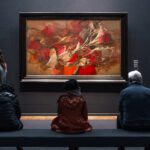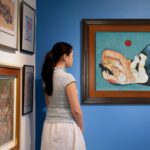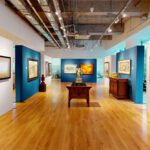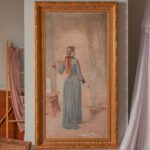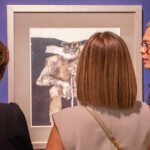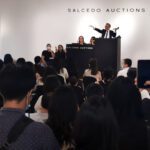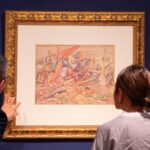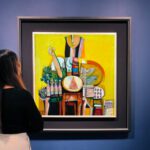Atomic.
This was the word David Medalla once used to describe himself as an artist. Indeed, throughout the course of his nomadic journey around the world, he has proven to be exactly that― a cosmic force unbound.
Perhaps that’s why no one word or single art movement can precisely define what David Medalla has contributed to the international and local art scene. His capacity to transcend genres made his work uniquely his own and also enabled his audience to form a connection with his pieces simply by sharing in their time and space. It’s also why, wherever Medalla went, he would inevitably form part of several important vanguard art movements.
A Stitch in Time was inspired by a pair of handkerchiefs Medalla gifted to parting lovers. The story goes, he came across one of the handkerchiefs a year later, fixed onto the backpack of a stranger at an airport in Amsterdam. Through that serendipitous reunion, Medalla realized the colorful journey that the handkerchief had gone through, with different people stitching their names onto it and leaving tangible parts of themselves on his unintentional work of art. This led to the creation of A Stitch In Time, an interactive art installation that has been showcased all over the world. With an introduction from Salcedo Private View, A Stitch in Time served as a highlight piece of Art Fair Philippines in 2019.
Medalla led a life oceans away from the Philippines in his tireless pursuit of art and self-discovery. Adam Nankervis, when talking about his late husband and long-time collaborator, shares, “New York was his (Medalla’s) spiritual home; London, his formulation; Berlin was the hearth; and Manila, his heart.” Deeply aware of the spaces that he inhabited, the artist became entrenched in the pulse of every city he lived in― finding a way to reflect its sights, sounds, and even emotions in his creations.
This landmark show exemplified Medalla’s extensive contributions to the international art scene. Some art critics have actually referred to him as a “British artist.” Interestingly, Medalla once shared that the UK Government had offered him citizenship because of his achievements and innovations in art, yet he politely declined. To his dying day, he proudly held on to his Filipino citizenship, travelling with a passport that created rather than eliminated barriers, as a constant reminder of his roots.
Medalla’s lifelong dedication to the arts began at a young age, when he first encountered the poetry of the greats― Shakespeare, Rimbaud, Whitman, and Proust. These remembrances of things past continued to shape his art as he would later on create many homages and tributes to these figures. The Cloud Canyons, better known as the Bubble Machines, reinvented the long-accepted idea of a sculpture, and it is one of the first examples of kinetic art and indeed the foremost example of auto-creative sculpture, cementing Medalla’s place in world art history. Cloud Canyons was constantly in motion― a display of energy and life itself. The inspiration for this piece, like many of Medalla’s oeuvres, was not rooted in a single moment but, rather, was fueled by a multitude of experiences from different points in time.
The homecoming, three decades in the making
“Will people still remember me?,” David Medalla asked Salcedo Auctions Chairman & Chief Specialist Richie Lerma, then Director & Chief Curator of the Ateneo Art Gallery, at an art symposium in Madrid hosted by Casa Asia as part of its landmark Filipiniana exhibition in 2006. At this point in time, Medalla shared that he hadn’t been to the Philippines since the early 80’s, describing such trips as ‘clandestine’ visits.
In his absence, his reputation preceded him. Much of his career was spent traveling and living in Europe and the United States. He had grown to become somewhat of an elusive rockstar in the local art scene― many knew of him but had not had the pleasure of seeing the artist or his work in person.
Overseas, Medalla was setting a path that few have since dared to follow. Here in his homeland, we were sorely missing out on his artistic genius. All this while, however, Medalla never lost sight of the motherland.
Lerma recalls a follow up encounter he had with Medalla in 2010: “We kept in contact via email after our initial meeting in Madrid. Some time later, I found myself scheduled to visit London for work, and so I contacted David right away to see if we could meet up.”
Medalla and Lerma met up at a cafe beside a train station after lunch. There, the co-founder of the country’s premier auction house broached the idea of Medalla’s return to Manila for what would be the artist’s first solo exhibition in over thirty years. Again, Medalla reiterated his hesitations about coming home after being away for so long. In response, Lerma assured him that he had not disappeared into obscurity. In fact, Medalla’s fear couldn’t be further from the truth as he had quite an audience that remained enthralled of his work. If anything, the nation was more than ready to welcome him home.
With lunch all wrapped up, Medalla asked Lerma to accompany him around town for the day. The events that would transpire after would turn out to be quite the surreal adventure, one that Lerma still fondly remembers today.
“It started with a drive out to the outskirts of London. All I knew was that we were to attend a performance by a group of his artist-friends.” Upon arriving at the performance space, Lerma quickly realized that this experience would be unlike any other. “The venue was far from what you would call traditional― it was an enclosed allotment, small plots with wooden shacks where locals could plant vegetables,” he describes.
“We couldn’t find our way in, but David was unfazed. After some time, he resorted to climbing the chicken wire fence to get in, and of course I had to follow him― imagine two grown men in jackets fence-hopping like teenagers!” And this wasn’t even the performance yet!
Once inside, Lerma recalls seeing a fresh patch dug up to resemble a grave. “We all gathered around it, I was standing elbow-to-elbow beside strangers― bearded ladies, bohemian men and women, bewildered spectators like myself, it felt like an entire community!” And as performance art typically requires the participation of the audience, everyone was asked to sing, chant, and throw flowers into the “grave.” It was more than just a performance― it was an intimate and outlandish celebration of life itself. In many ways, parallelisms can be drawn between this surreal adventure and Medalla’s fantastical approach to his own life and art.
The Homecoming Exhibit
This unforgettable London meeting would eventually result in, Tuloy Po Kayo, Welcome!, Medalla’s homecoming exhibition hosted by the Ateneo Art Gallery in November 2012. The exhibition showcased the transcendent nature of Medalla’s work. These ranged from acrylic paintings on paper depicting individuals from his memory who had served as bridges between the Philippines and the world in fields as diverse as theater and ethnography.
The collection also included rare exemplars of his sand paintings, created using a complex technique which involved the artist cutting out stencil forms on plastic tubes filled with sand that he rolled over primed wood planks, the adhered granules leaving whimsical forms unified by swathes of matte gold paint.
In his first homecoming, Salcedo Auctions hosted an event for David Medalla to authenticate his artworks. The country’s premier auction house organized meetings, private dinners, and showed the artist’s opuses during the inaugural Art Fair Philippines in 2013, introducing the artist to the country’s most important art collectors and the wider public.
In January 2013, in collaboration with Salcedo Auctions, W/17, a luxury lifestyle store, hosted an intimate dinner in honor of David Medalla where guests were also able to acquire his works.
Photos courtesy of Inquirer Lifestyle
Throughout his career, David Medalla was never once static. He was both a pioneer and a perpetual student of the world. It was this innate ability to constantly reinvent himself amid his changing surroundings that allowed him to thrive in the international art scene, making waves wherever he went. He led a truly bubbly, evanescent life surrounded by friends, many of whom fondly remember the wandering artist’s empathetic nature and vivacious outlook.
Medalla once said that he felt a sense of belonging wherever he went, but still, he carried the unwavering passion for his homeland every step of the way. Despite spending most of his career many miles away from Manila, his final years were spent here, in this city he called home. In the past decade, David Medalla continued to create and innovate― serving as a guiding light for those who dare to dream big and venture beyond the norm.
Is it possible that this visionary was prophetic in some way? In his lifetime, Medalla managed to mold himself anew through the transitory periods in his career, becoming a transcendent, irreplaceable, unmatched, and an unquestionably atomic artist each time.
He will be greatly missed.






